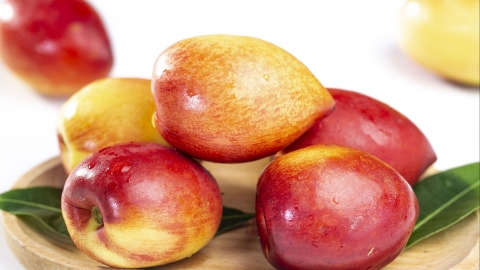What is the difference between nectarines and regular peaches?
Generally speaking, nectarines and peaches are two different varieties of peaches, differing in characteristics such as skin features, flesh texture, taste, ripening time, and storage methods. If differentiation is needed during selection or consumption, one can judge based on their specific characteristics. The detailed analysis is as follows:
1. Skin Characteristics
Nectarines have smooth, hairless skins that are relatively thick and glossy, usually in shades of red, yellow, or a combination of red and yellow. Their skin is firm and resistant to damage. In contrast, peaches have fine, velvety fuzz covering their surface, and their colors vary, including pink, white, and yellow. The skin of peaches is relatively thin, and the fuzz easily脱落 or sticks to the hands.

2. Flesh Texture
Nectarine flesh is firm, elastic, finely textured, and crisp-tender, maintaining its texture even when ripe, making it more resistant to becoming overly soft; peach flesh varies depending on the variety—some are soft and juicy, while others are slightly crisp and firm—but overall, the fibers are coarser, and the flesh tends to soften easily when ripe, sometimes even turning mushy.
3. Taste and Flavor
Nectarines have a balanced sweet and sour taste, with high sweetness and mild acidity, and a fresh, intense aroma. Due to the absence of fuzz, they offer a cleaner and smoother eating experience. Peaches are sweeter, with some varieties having a more noticeable tartness and a rich, mellow aroma. However, the fuzz on the skin may feel slightly coarse to some people.
4. Ripening Time
Nectarines ripen earlier, generally appearing in the market from May to July, with some early-maturing varieties ready as early as early May. Peaches ripen slightly later, mostly available from June to September, with late-maturing varieties extending into October, showing a larger variation in ripening times among different varieties.
5. Storage Methods
Due to their smooth and tough skin, nectarines are more resistant to storage and can last about a week in a cool, well-ventilated place, with longer storage possible under refrigeration. Peaches, however, have thinner skin with fuzz, making them prone to bruising and bacterial contamination, resulting in a shorter shelf life. At room temperature, they can be stored for about 3-5 days, and stacking or squeezing should be avoided.
In daily life, the presence or absence of fuzz on the skin can quickly distinguish the two. Both nectarines and peaches should be thoroughly washed before consumption. It is recommended to peel peaches or soak them in salt water to remove the fuzz. Consumption should be moderate, especially for those with weak spleen and stomach. When storing, choose appropriate methods based on variety characteristics to avoid spoilage and waste.








